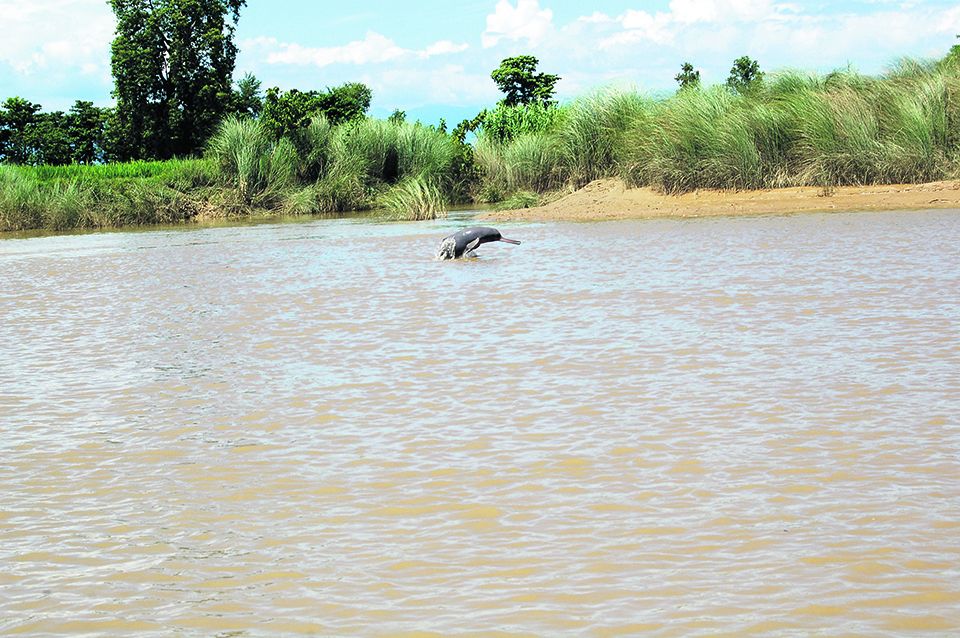I have had my fair share of adventure while researching. Ascending 900 m from the banks of Mahakali River in three hours along the rocky hilly terrains; searching for the elusive Ganges river dolphin in the Karnali, Narayani, and Koshi river systems; hiking soaking wet for biomonitoring in the monsoonal rains in the headwaters of Bagmati to name just a few but these experiences could not hold a candle to my recent research.
Recently, I surveyed more than 210 km of Karnali River with an addition of another 55 km of West Seti rafting. The surveys conducted in three phases were a combination of rafting and hiking along riverbanks. The later experience of white water rafting in West Seti is especially etched in my memory with the crystal-clear water where we could see schools of fish swimming by right underneath our boats and the large rocks which were scattered at intervals, breaking the river flow made for the most thrilling rapids. In some parts of the research, we slept in tents, and I witnessed one of the starriest nights of my life.
But the adventure and fun that came along was only a by-product because our aim was to study otters, fishes, dolphins, and gharials. For otter surveys we looked for their signs; for fish we listed the species recorded, assessed their total biomass and length; and with dolphins and gharials we estimated their abundance. During all these surveys we made a note of human disturbances, the habitat condition, and different physico-chemical parameters.
Mrityu Diary: A must read book about life and death

The elusive smooth-coated otter was very hard to observe and the tiniest of human presence would make them run away. But we were lucky to observe them directly and were also able to mark their presence with spraints and tracks. The dolphins were only found in Karnali branch (a few kilometers downstream the Karnali River breaks into different segments) and in deep pools whereas gharials were found basking in the sand banks.
During the dolphin survey in Karnali branch, more than 60 % of these segments had some form of human disturbance (fishing and/or boating). River training work (e.g., embankment construction) for flood control was ongoing and river mining could be witnessed at intervals. Geruwa which had no water for almost 2 km of bifurcation with Karnali and Kharaha channels had inadequate water and surveys along these segments had to be conducted on foot. Although both these riverine segments are protected, the lack of adequate water presents a threat to riverine species. As hydropower plants and other developments are planned along Karnali and West Seti, the rafting industry is certain to be impacted and also representing a threat to the survival of many freshwater species.
Surveys along Geruwa and parts of Khauraha which required active hiking was another adventure in itself. Fresh paws from a lot of large mammals could be found along our trail from tigers, rhinoceros, elephants and more. Part of my team also encountered live rhinoceros and wild elephants in Khauraha.
Our team consisted of indigenous fishers who shared with us how they can make out the time by looking into the stars. They shared that during their fishing trips they slept on top of boulders to steal a moment’s rest and later carry on fishing throughout the night. During the surveys, they would be first to catch a glimpse of the dolphins and detect tracks much faster than any of us. But indigenous knowledge is rapidly being lost, many in the younger generation do not carry the wisdom of their forebearers.
I am in awe of the biodiversity that Nepal boasts, and this study has renewed my commitment for conservation of these species and their habitat. The habitats of many of these species do overlap with humans. Otters for instance are known to be a nuisance to many fishers because they cut the nets and take their catch. But they are an essential part of the ecosystem as they help in keeping food webs in balance. Dolphins are now exclusively found in the Karnali segment that overlap with areas of fishing, irrigation exaction, and mining and move referred to as ‘ecological trap’ by Khanal et al (2016). And while this study did not deal with tigers it is worth noting their increase in number has corresponded to increase in fatalities. Hence, there is an urgent need to approach conservation holistically, not only protecting wildlife but also supporting the communities and knowledge systems that share the space with them. Coexistence is the need of the hour.
The author is affiliated to River Dolphin Trust





































